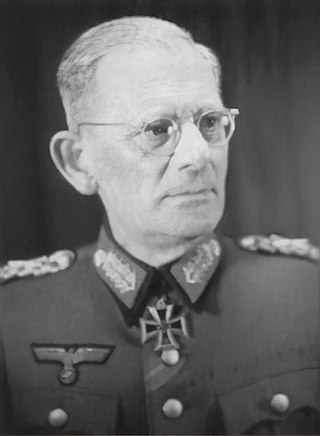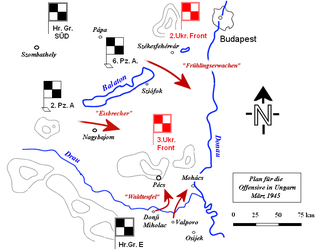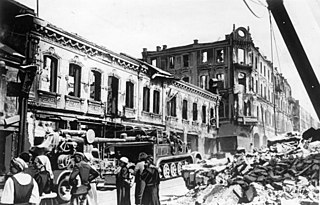
Moritz Albrecht Franz Friedrich Fedor von Bock was a German Generalfeldmarschall who served in the German Army during the Second World War. Bock served as the commander of Army Group North during the Invasion of Poland in 1939, commander of Army Group B during the Invasion of France in 1940, and later as the commander of Army Group Center during the attack on the Soviet Union in 1941; his final command was that of Army Group South in 1942.

Maximilian Maria Joseph Karl Gabriel Lamoral Reichsfreiherr von und zu Weichs an der Glon was a field marshal in the Wehrmacht of Nazi Germany during World War II.
Army Group Centre was the name of two distinct strategic German Army Groups that fought on the Eastern Front in World War II. The first Army Group Centre was created on 22 June 1941, as one of three German Army formations assigned to the invasion of the Soviet Union. On 25 January 1945, after it was encircled in the Königsberg pocket, Army Group Centre was renamed Army Group North, and Army Group A became Army Group Centre. The latter formation retained its name until the end of the war in Europe on 11 May after VE Day.

Paul Ludwig Ewald von Kleist was a German field marshal during World War II. Kleist was the commander of Panzer Group Kleist, the first operational formation of several Panzer corps in the Wehrmacht during the Battle of France, the Battle of Belgium, the Invasion of Yugoslavia and Operation Barbarossa, the invasion of the Soviet Union.

Operation Spring Awakening was the last major German offensive of World War II. The operation was referred to in Germany as the Plattensee offensive and in the Soviet Union as the Balaton defensive operation. It took place in Western Hungary on the Eastern Front and lasted from 6 March until 15 March, 1945. The objective was to secure the last significant oil reserves still available to the European Axis powers and prevent the Red Army from advancing towards Vienna. It was a failure for Nazi Germany.
Army Group A was the name of several German army groups during World War II. During the Battle of France, Army Group A was composed of 45½ divisions, including 7 panzer divisions. It was responsible for breaking through the heavily-forested Ardennes region. The operation, which was part of Fall Gelb, was resoundingly successful for the Germans, as the army group outflanked the best troops of France and its allies, eventually leading to France's surrender.

For the battle of battle of Smolensk 1812 see, Battle of Smolensk (1812)

The 2nd Panzer Division was an armoured division in the German Army, the Heer, during World War II.
XXXXVIII Panzer Corps, was a corps-level formation of the German Army which saw extensive action on both the Eastern and Western Fronts during World War II.
The 2nd Panzer Army was a German armoured formation during World War II, formed from the 2nd Panzer Group on October 5, 1941.
Army Group D was a German Army Group which saw action during World War II.

The Battle of Białystok–Minsk was a German strategic operation conducted by the Wehrmacht's Army Group Centre under Field Marshal Fedor von Bock during the penetration of the Soviet border region in the opening stage of Operation Barbarossa, lasting from 22 June to 9 July 1941.
Army Group G fought on the Western Front of World War II and was a component of OB West.

The 11th Army was a World War II field army.

The Upper Rhine High Command, also incorrectly referred to as Army Group Upper Rhine, was a short-lived headquarters unit of the German Armed Forces (Wehrmacht) created on the Western Front during World War II. The Upper Rhine High Command was formed on 26 November 1944 and deactivated on 25 January 1945. The sole commander of this headquarters unit was Heinrich Himmler.
Army Group F was a strategic command formation of the Wehrmacht during the Second World War. The commander of Army Group F served also as the Oberbefehlshaber Südost.
Albert Praun was a German general who became the Chief Signals Officer of the Wehrmacht during World War II.

Army Group H, Army Group Northwest after March 1945, was a German army group in the Netherlands and in Nordrhein-Westfalen during World War II.
The XIX Army Corps was an armored corps of the German Wehrmacht between 1 July 1939 and 16 November 1940, when the unit was renamed Panzer Group 2 and later 2nd Panzer Army. It took part in the Invasion of Poland and the Battle of France.